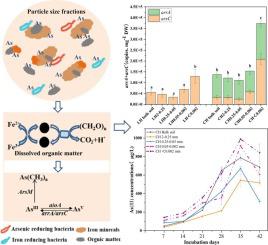Journal of Hazardous Materials ( IF 13.6 ) Pub Date : 2022-09-30 , DOI: 10.1016/j.jhazmat.2022.130100 Qi Zou 1 , Hang Wei 1 , Zhiliang Chen 2 , Ping Ye 3 , Jianqiang Zhang 2 , Mengqiang Sun 2 , Ling Huang 2 , Jing Li 4

|
Soil particle size fractions (PSFs) are important for arsenic (As) partitioning, migration, and speciation transformation. However, information is lacking about the environmental fate of As and its distribution on different PSFs. In the present study, two types of soils from mining areas were divided into four PSFs, including coarse sand (2–0.25 mm), fine sand (0.25–0.05 mm), silt (0.05–0.002 mm), and clay (< 0.002 mm) fractions. The results showed that As was enriched in the coarse sand, which was primarily affected by the content of organic carbon (OC), followed by iron (Fe), aluminum (Al), and manganese (Mn) (hydr)oxides. The elevated total As (TAs), As(III), organic As, Fe(II), and dissolved organic carbon (DOC) concentrations were mainly originated from the clay fraction. The intensified humification degree of DOM and promoted bacterial metabolism related to As/iron bioreduction were also exhibited in the clay fractions. The dynamics of As fractions in soils indicated the potential formation of secondary minerals and re-adsorption of As in the PSFs. The highest abundances of arrA, arsC, arsM, and Geo genes were found in the clay fraction, implying that the clay fraction potentially released more As, including As(III) and organic As. Results from the correlation analysis showed that elevated DOC concentrations promoted the catabolic responses of iron-reducing microorganisms and triggered microbial As detoxification. Overall, this study provides valuable information and guidance for the remediation of As-contaminated soils.
中文翻译:

土壤颗粒大小分数影响砷 (As) 释放和形态:对溶解有机物和功能基因的洞察
土壤粒度分数 (PSF) 对于砷 (As) 分配、迁移和形态转化很重要。但是,缺乏关于 As 的环境归宿及其在不同 PSF 上的分布的信息。在本研究中,矿区的两种土壤被分为四种 PSF,包括粗砂(2-0.25 毫米)、细砂(0.25-0.05 毫米)、粉砂(0.05-0.002 毫米)和粘土(< 0.002毫米)分数。结果表明,As富集在粗砂中,主要受有机碳(OC)含量的影响,其次是铁(Fe)、铝(Al)和锰(Mn)(氢)氧化物。升高的总砷 (TAs)、砷 (III)、有机砷、铁 (II) 和溶解有机碳 (DOC) 浓度主要来自粘土部分。在粘土组分中也表现出 DOM 的腐殖化程度增强和与 As/铁生物还原相关的促进细菌代谢。土壤中 As 组分的动态表明次生矿物的潜在形成和 As 在 PSF 中的再吸附。丰度最高的arrA、arsC、arsM和Geo基因在粘土部分中被发现,这意味着粘土部分可能会释放更多的 As,包括 As(III) 和有机 As。相关分析的结果表明,DOC 浓度升高会促进铁还原微生物的分解代谢反应,并触发微生物 As 解毒。总的来说,这项研究为砷污染土壤的修复提供了有价值的信息和指导。


























 京公网安备 11010802027423号
京公网安备 11010802027423号